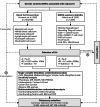Causal association between circulating blood cell traits and pulmonary embolism: a mendelian randomization study
- PMID: 38863024
- PMCID: PMC11167760
- DOI: 10.1186/s12959-024-00618-3
Causal association between circulating blood cell traits and pulmonary embolism: a mendelian randomization study
Abstract
Background: Pulmonary embolism (PE) is a life-threatening thromboembolic disease for which there is limited evidence for effective prevention and treatment. Our goal was to determine whether genetically predicted circulating blood cell traits could influence the incidence of PE.
Methods: Using single variable Mendelian randomization (SVMR) and multivariate Mendelian randomization (MVMR) analyses, we identified genetic associations between circulating blood cell counts and lymphocyte subsets and PE. GWAS blood cell characterization summary statistics were compiled from the Blood Cell Consortium. The lymphocyte subpopulation counts were extracted from summary GWAS statistics for samples from 3757 individuals that had been analyzed by flow cytometry. GWAS data related to PE were obtained from the FinnGen study.
Results: According to the SVMR and reverse MR, increased levels of circulating white blood cells (odds ratio [OR]: 0.88, 95% confidence interval [CI]: 0.81-0.95, p = 0.0079), lymphocytes (OR: 0.90, 95% CI: 0.84-0.97, p = 0.0115), and neutrophils (OR: 0.88, 95% CI: 0.81-0.96, p = 0.0108) were causally associated with PE susceptibility. MVMR analysis revealed that lower circulating lymphocyte counts (OR: 0.84, 95% CI: 0.75-0.94, p = 0.0139) were an independent predictor of PE. According to further MR results, this association may be primarily related to HLA-DR+ natural killer (NK) cells.
Conclusions: Among European populations, there is a causal association between genetically predicted low circulating lymphocyte counts, particularly low HLA-DR+ NK cells, and an increased risk of PE. This finding supports observational studies that link peripheral blood cells to PE and provides recommendations for predicting and preventing this condition.
Keywords: HLA-DR+ NK cells; Lymphocyte subsets; Mendelian randomization; Peripheral blood cell; Pulmonary embolism.
© 2024. The Author(s).
Conflict of interest statement
The authors declare no competing interests.
Figures





Similar articles
-
Genetically defined causal effects of natural killer cells related traits in risk of infection: a Mendelian randomization study.BMC Infect Dis. 2024 Sep 17;24(1):986. doi: 10.1186/s12879-024-09890-0. BMC Infect Dis. 2024. PMID: 39289620 Free PMC article.
-
The genetic relationships between immune cell traits, circulating inflammatory proteins and preeclampsia/eclampsia.Front Immunol. 2024 May 30;15:1389843. doi: 10.3389/fimmu.2024.1389843. eCollection 2024. Front Immunol. 2024. PMID: 38873604 Free PMC article.
-
Causal relationship between circulating immune cells and the risk of type 2 diabetes: a Mendelian randomization study.Front Endocrinol (Lausanne). 2023 May 25;14:1210415. doi: 10.3389/fendo.2023.1210415. eCollection 2023. Front Endocrinol (Lausanne). 2023. PMID: 37305035 Free PMC article.
-
Bidirectional associations between eosinophils, basophils, and lymphocytes with atopic dermatitis: A multivariable Mendelian randomization study.Front Immunol. 2022 Dec 9;13:1001911. doi: 10.3389/fimmu.2022.1001911. eCollection 2022. Front Immunol. 2022. PMID: 36569933 Free PMC article.
-
The relationship between blood lipid and risk of psoriasis: univariable and multivariable Mendelian randomization analysis.Front Immunol. 2023 Jun 22;14:1174998. doi: 10.3389/fimmu.2023.1174998. eCollection 2023. Front Immunol. 2023. PMID: 37426655 Free PMC article.
Cited by
-
From Cell Interactions to Bedside Practice: Complete Blood Count-Derived Biomarkers with Diagnostic and Prognostic Potential in Venous Thromboembolism.J Clin Med. 2025 Jan 2;14(1):205. doi: 10.3390/jcm14010205. J Clin Med. 2025. PMID: 39797287 Free PMC article. Review.
-
Causal relationship between immune cells and venous thromboembolism: a bidirectional two-sample Mendelian randomization study.Thromb J. 2025 Aug 5;23(1):78. doi: 10.1186/s12959-025-00754-4. Thromb J. 2025. PMID: 40764987 Free PMC article.
-
Nomogram based on lymphocyte-associated inflammatory indexes predicts portal vein thrombosis after splenectomy with esophagogastric devascularization.BMC Gastroenterol. 2024 Sep 19;24(1):321. doi: 10.1186/s12876-024-03416-3. BMC Gastroenterol. 2024. PMID: 39300346 Free PMC article.
References
Grants and funding
LinkOut - more resources
Full Text Sources
Research Materials

